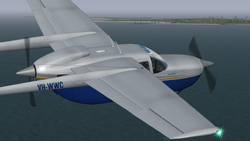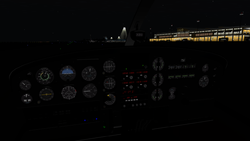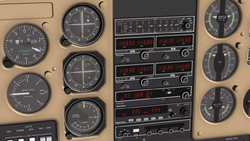Cessna 337G Skymaster
 | |
|---|---|
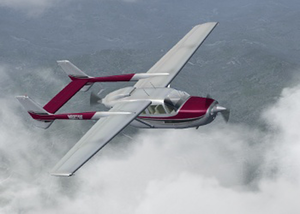 | |
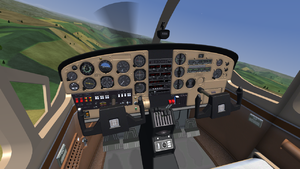 General view of the Skymaster cockpit | |
| Type | Civil utility aircraft |
| Configuration | Twin boom aircraft, High wing aircraft |
| Propulsion | Push-pull aircraft, Propeller aircraft |
| Manufacturer | Cessna |
| Author(s) |
|
| FDM | JSBSim |
| --aircraft= | Cessna337 |
| Status | Production |
| FDM |
|
| Systems |
|
| Cockpit |
|
| Model |
|
| Development | |
| Website |
|
| Repository |
|
| Download |
|
| License | GPLv2+ |
|
| |
The Cessna 337 is a twin-engine aircraft built in a push-pull configuration. Instead of the engines being mounted on the wings, one is mounted on the nose and the other at the rear of the pod-style fuselage. The stabilizers are mounted on booms that extend from the wings. The Skymaster has a retractable undercarriage that gives it that little bit of extra speed.
The combination of a tractor and a pusher engine produces a unique sound.
Aircraft help
Aircraft keys
| Key | Function |
|---|---|
| d | Open/close cockpit door |
| c | Open/close front cowl flaps |
| C | Open/close rear cowl flaps |
| m/⇧ Shift+M | Adjust fuel mixture |
| n/⇧ Shift+N | Adjust speed governor (propeller pitch) |
Limits
- VNE: 198 KIAS (Never exceed speed)
- VNO: 167 KIAS (Max. speed for normal operations)
- VA: 140 KIAS (Design maneuvering speed)
- VFE: 109 KIAS (Max. full flap extended speed)
- VLE: 200 KIAS (Max. landing gear extended speed)
- VLO: 140 KIAS (Max. landing gear extend/retract speed)
- Stall speed, full flaps: 61 KIAS
- Stall speed, zero flaps: 70 KIAS
- Max. weight: 4630 lbs. (2100 kg)
- Service ceiling (two engines): 18,000 ft
- Ground run for takeoff: 1,000 ft
- Ground roll for landing 700 ft
Normal procedures
Startup
- Turn ON battery and front and rear generators
- Turn ON master avionics button (left wall panel)
- Turn ON the avionics (NAV/COMM Radios, DME, ADF...)
- Turn ON fuel pumps (not implemented yet)
- Turn ON required lights and pitot heat
- Open front and rear cowl flaps
- Turn ON rear magnetos (mouse wheel), continue turning the knob for starter (left button)
- Turn ON front magnetos, continue turning the knob for starter
Takeoff
- Check open front & rear cowl flaps to avoid overheating
- Check rich mixture and high RPM speed governor (propeller pitch)
- Full throttle, release brakes
- Rotate at 60 KIAS
- Retract gear
Cruise
The Cessna 337 Skymaster has a constant-speed propeller; so, you can increase propeller pitch to get more airspeed, but with a loss of engine RPM and power.
- Decrease throttle to desired power
- Decrease RPM with speed governor (propeller pitch)
- Adjust mixture depending on flight altitude (for 5000ft or more). Check EGT for best mixture.
- Close cowl flaps
Landing
- Open cowl flaps
- Increase RPM with speed governor (propeller pitch) to maximum
- Reduce power with throttle
- Open landing gear
- Deploy flaps gradually under 110 KIAS
- Touchdown at 75/60 KIAS, depending on aircraft weight
Systems
The Cessna 337 still in development, but it has some suitable systems. Electrical, vacuum and fuel system are working, but they have no failure system modeled yet. Users can adjust the weight of each seat on the plane and fuel amount. Almost all buttons, knobs and levers are functional and properly animated, and all instruments are labeled for a properly identification.
About knobs, use scroll mouse for gross adjustments, and left-central buttons for fine tuning. When setting radio frequencies, the mouse scroll will adjust integral numbers, and buttons will tune decimals. Try that method with instruments, cowl flap switches, trim levers, magnetos, etc.
Avionics
The Skymaster release is provided with a working Bendix/King avionics pack, capable of full IFR/night navigation:
- 2 KX-155 COMM/NAV Radios, attached to a pair of KI-206 VOR locators
- KN-62A DME receiver with internal frequency hold and NAV1 remote operation
- KR-87 ADF receiver, attached to a KI-227 ADF locator
- KMA-24 Audio panel
- KT-76A Transponder, with radar sweep simulation
- KI-250 Radar altimeter, capable to mark decision height for low-visibility landings
- Hobbs Meter
| Note A full KMA24 audio panel implementation was added in January 2017. The knob on the right of the unit switches the speaker amplifier on and off and also controls the marker beacon receiver. To hear ATIS broadcasts, either switch the comm radio output using the COMM phone switch, or use the COMM speaker switch with the knob in any position other than off. To hear marker beacon idents, the knob must be in any other position than off and one of the MKR switches selected on the panel. |
Radio stack instruments are modeled according to the Bendix King pilot guides. Refer to those guides for operating instructions. [1]
Autopilot
The Cessna 337G Skymaster/Navomatic 400A autopilot has a fully working 3D panel and dialog.
ELT
The ELT (Emergency Locator Transmitter) is a device which send a message in case of aircraft crash. That message contains info about aircraft model, owner and approximate coordinates of the crashed plane, and it is made to request SAR (Search and Rescue) services. The Cessna Skymaster is the first plane equipped with a functional ELT on FlightGear.
External links
- Cessna 337G official forum post
- Video Cessna 337G MPG HD
- Bendix King Silver Crown Plus Avionics Systems Pilot’s Guide
| ||||||||
